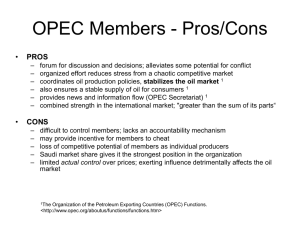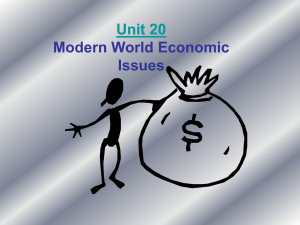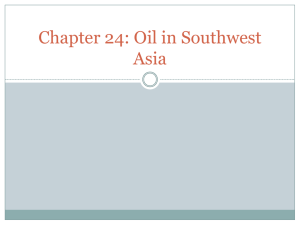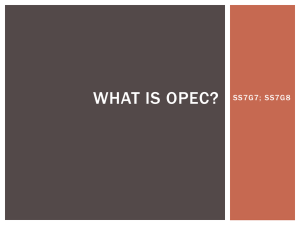Social Studies - World Geography - Oil in the Middle East and Africa
advertisement
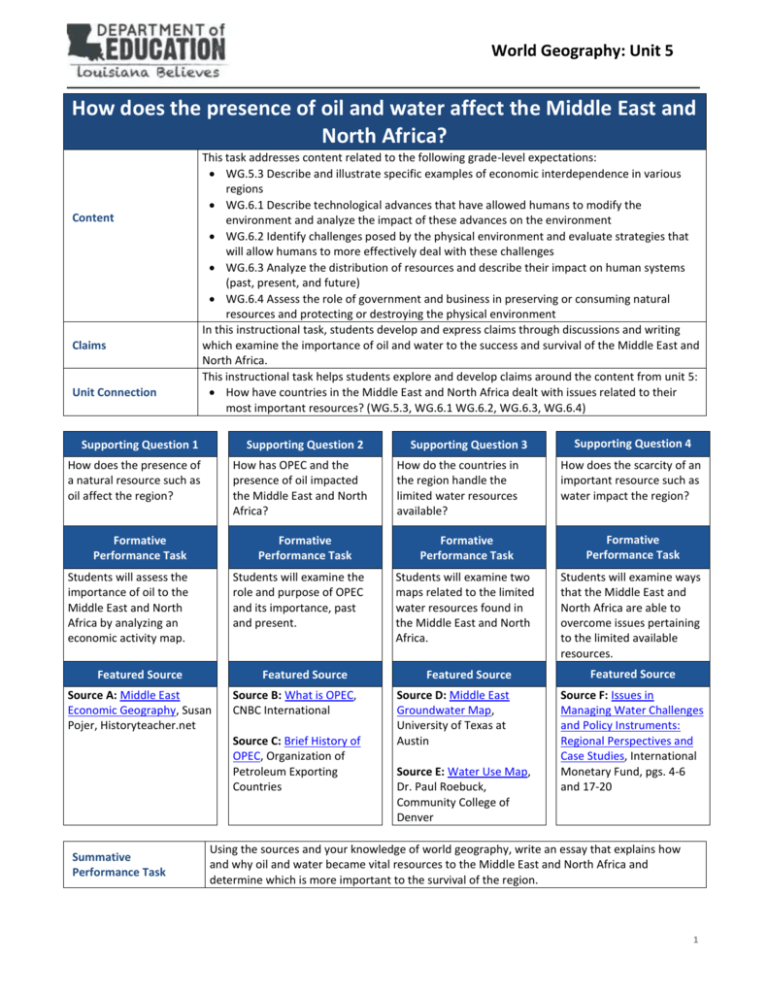
World Geography: Unit 5 How does the presence of oil and water affect the Middle East and North Africa? Content Claims Unit Connection This task addresses content related to the following grade-level expectations: WG.5.3 Describe and illustrate specific examples of economic interdependence in various regions WG.6.1 Describe technological advances that have allowed humans to modify the environment and analyze the impact of these advances on the environment WG.6.2 Identify challenges posed by the physical environment and evaluate strategies that will allow humans to more effectively deal with these challenges WG.6.3 Analyze the distribution of resources and describe their impact on human systems (past, present, and future) WG.6.4 Assess the role of government and business in preserving or consuming natural resources and protecting or destroying the physical environment In this instructional task, students develop and express claims through discussions and writing which examine the importance of oil and water to the success and survival of the Middle East and North Africa. This instructional task helps students explore and develop claims around the content from unit 5: How have countries in the Middle East and North Africa dealt with issues related to their most important resources? (WG.5.3, WG.6.1 WG.6.2, WG.6.3, WG.6.4) Supporting Question 1 Supporting Question 2 How does the presence of a natural resource such as oil affect the region? How has OPEC and the presence of oil impacted the Middle East and North Africa? Formative Performance Task Formative Performance Task Students will assess the importance of oil to the Middle East and North Africa by analyzing an economic activity map. Students will examine the role and purpose of OPEC and its importance, past and present. Featured Source Featured Source Source A: Middle East Economic Geography, Susan Pojer, Historyteacher.net Source B: What is OPEC, CNBC International Source C: Brief History of OPEC, Organization of Petroleum Exporting Countries Summative Performance Task Supporting Question 3 How do the countries in the region handle the limited water resources available? Supporting Question 4 How does the scarcity of an important resource such as water impact the region? Formative Performance Task Formative Performance Task Students will examine two maps related to the limited water resources found in the Middle East and North Africa. Students will examine ways that the Middle East and North Africa are able to overcome issues pertaining to the limited available resources. Featured Source Source D: Middle East Groundwater Map, University of Texas at Austin Source E: Water Use Map, Dr. Paul Roebuck, Community College of Denver Featured Source Source F: Issues in Managing Water Challenges and Policy Instruments: Regional Perspectives and Case Studies, International Monetary Fund, pgs. 4-6 and 17-20 Using the sources and your knowledge of world geography, write an essay that explains how and why oil and water became vital resources to the Middle East and North Africa and determine which is more important to the survival of the region. 1 World Geography: Unit 5 Formative Performance Task 1 Supporting Question How does the presence of a natural resource such as oil affect the region? Formative Performance Task Students assess the importance of oil to the Middle East and North Africa by analyzing a natural resource map. Featured Source Source A: Middle East Economic Geography, Susan Pojer, Historyteacher.net Content and Claims This formative performance task requires students to analyze the affect the distribution of resources have and have had on the region. (WG.6.3) Featured Source Source A: Middle East Economic Geography, Susan Pojer, Historyteacher.net Steps 1. Display Source A: Middle East Economic Geography and allow students a few minutes to examine the map. Point out to students the difference between land use (shaded areas) and resources (symbols). 2. Students should complete the map analysis worksheet independently. 3. In small groups, have students answer questions related to the map. Lead a discussion on students responses. Possible guiding questions include: What types of economic activities are present in this region? What do these activities tell us about the region? Which natural resources do studens feel are the most valuable? Focusing on the areas where oil is located, ask students why it is an important resource not only to this region, but also worldwide? Student Look-Fors 1. Students should list that this regions predominant activities are nomadic herding and farming, both of which are indicative of a region that is not highly developed and has an economy that is likely not very strong or diverse. 2. Students should indicate that oil is an important, valuable resource that is located in many countries throughout the region. 3. Students should describe some of the benefits of being an oil rich country, including the economic benefits, employment opportunities, etc. 4. Students may also describe the worldwide impact of oil in this region including exporting oil to other countries, possibly OPEC and related issues. 2 World Geography: Unit 5 Formative Performance Task 2 Supporting Question How has OPEC and the presence of oil impacted the Middle East and North Africa? Formative Performance Task Students will examine the role and purpose of OPEC and its importance, past and present. Featured Source Source B: What is OPEC, CNBC International Source C: Brief History of OPEC, Organization of Petroleum Exporting Countries Content and Claims In this formative performance task, students will examine and trace the role and influence of OPEC regionally as well as worldwide. (WG.5.3, WG.6.3, WG.6.4) Featured Source Source B: What is OPEC?, CNBC International Source C: Brief History of OPEC, Organization of Petroleum Exporting Countries Steps 1. Play Source B: What is OPEC? as an introduction for students. 2. After viewing, students will identify key features of OPEC by completing the OPEC True/False handout on the next page. 3. Provide students with access to Source C: Brief History of OPEC to students. 4. Ask students to read the text in small groups and complete a timeline on significant events that have occurred in OPEC’s history. A sample timeline is included below. 5. Instruct students to compose an individual response to the following prompt: Has the presence of oil had a positive or negative impact on the region? Respond in writing to the question. Be sure to explain the role OPEC has played in fostering the importance of oil to this region and how things would have been different had OPEC never been formed. 6. Allow students time to answer the prompt. 7. Have student volunteers share answers and lead a discussion based on their responses. 3 World Geography: Unit 5 OPEC TRUE/FALSE STATEMENTS Directions: Read each statement carefully. For each statement, determine whether each statement is true or false. If a statement is true, provide evidence to support your claim. If a statement is false, rewrite the statement to make it true and provide evidence to support your claim. 1. OPEC stands for the Organization of Petroleum Exporting Continents. True False Evidence: 2. OPEC controls the world’s oil reserves and produces the majority of the world’s oil supply. True False Evidence: 3. OPEC was founded by 6 countries in 1960. True False Evidence: 4. In 1973, OPEC imposed an embargo against the United States and parts of Europe. True False Evidence: 5. OPEC's objective is to coordinate and unify petroleum policies among petroleum producing countries, in order to secure fair and stable prices for all petroleum producers. True False Evidence: 4 World Geography: Unit 5 OPEC Timeline Directions: Create a timeline of the important events occurring since OPEC’s inception. On your timeline, list all events that have had a positive impact on OPEC and the region above the timeline in the same color. List all the events that have had a negative impact on OPEC and the region below the timeline in a different color. 1960 1970 1980 1990 2000 2010 5 2015 World Geography: Unit 5 Student Look-Fors 1. Students should correctly identify the historical information surrounding OPEC including origin, member countries, and purpose. A sample completed timeline is included below. 2. Student responses to the prompt should address the vital role this resource has played in this region since 1960. Using their timeline, events, and economic implications as evidence, students should determine if oil and OPEC has been a more negative or positive force in the region. 6 World Geography: Unit 5 Formative Performance Task 3 Supporting Question How do the countries in the Middle East and North Africa handle the limited water resources available? Formative Performance Task Students will examine two maps related to the limited water resources found in the Middle East and North Africa. Featured Source Source D: Middle East Groundwater Map, University of Texas at Austin Source E: Water Use Map, Dr. Paul Roebuck, Community College of Denver Content and Claims This formative performance task requires students to evaluate the effect the limited distribution of water resources has on the region. (WG.6.2, WG.6.3) Featured Source Source D: Middle East Groundwater Map, University of Texas at Austin Source E: Water Use Map, Dr. Paul Roebuck, Community College of Denver Steps 1. Divide the class into small groups. 2. Display or distribute Source D: Middle East Groundwater Map to each group for students to examine. Ask each group to respond to the following questions: What information about the Middle East and part of North Africa is this map providing? What do scant and desalinization mean? How do these terms relate to this region? What does this map illustrate about this region? What geographical problems exist in this region? 3. After allowing students enough time to discuss and write answers to the questions in their groups, lead a whole-class discussion where the groups share their answers. 4. Conclude the discussion by asking students: “What do you notice about the regions where water sources are ’generally plentiful’?” (Note: Depending on students’ background knowledge, discuss with students the historical and current importance of the Nile, Jordan, and Tigris and Euphrates Rivers.) 5. Display or distribute Source E: Water Use Map to each group for students to examine. Ask each group to respond to the following questions: What does “water stress” mean? What areas are the most critical in terms of its water resources? Are there any trends/similarities with these areas? Which areas have the most plentiful supplies of water? Are there any trends/similarities with these areas? What environmental concerns might be affecting the water supply of the region? Which areas are affected by this? 6. After allowing students enough time to discuss and write answers to the questions in their groups, lead a whole-class discussion where the groups share their answers. 7. Then, have students individually complete a RAFT writing assignment. 7 World Geography: Unit 5 Role: Traveling journalist visiting countries in the Middle East and North Africa Audience: Readers of an international publication Format: Editorial Topic: How does the distribution of water affect the way of life of people living in the Middle East and North Africa? Describe the availability of water in three countries you visited. Propose at least two solutions to this problem that could be implemented by the governments or the people living in this region. Student Look-Fors 1. Students should identify that water is a scarce, or scant, resource throughout this region. 2. Students note that freshwater is found near the region’s major river systems: the Nile, Jordan, and Tigris and Euphrates. 3. Students should note that places such as Algeria, Jordan, Yemen, and Saudi Arabia suffer the most from water stress. These areas are extremely dry and, except for Jordan, are not located near any freshwater. 4. Students should note that places such as Egypt, Iraq, and Libya have a more plentiful supply of water. Egypt and Iraq both have a freshwater supply available to them. 5. Student RAFTs should be reflective of the three countries that they visited and must propose at least two viable solutions to solving the water problem in this region. Information and evidence from the lesson should be used as evidence to back up student descriptions. 8 World Geography: Unit 5 Formative Performance Task 4 Supporting Question How does the scarcity of an important resource such as water impact the region? Formative Performance Task Students will examine ways that the Middle East and North Africa are able to overcome issues pertaining to the limited available resources. Featured Sources Source F: Issues in Managing Water Challenges and Policy Instruments: Regional Perspectives and Case Studies, International Monetary Fund, pgs. 4-6, 17-20 Content and Claims In this formative performance task, students determine the impact of a limited water supply in the region and assess and describe ways that the region can overcome this issue. (WG.6.1, WG.6.2, WG.6.3, WG.6.4) Featured Source Source F: Issues in Managing Water Challenges and Policy Instruments: Regional Perspectives and Case Studies, International Monetary Fund, pgs. 4-6, 17-20 Steps 1. Provide students with pages 4-6 of Source F: Issues in Managing Water Challenges and Policy Instruments: Regional Perspectives and Case Studies. 2. Ask students to read the source and complete split-page notes independently. See the next page for split-page notes handout. 3. Once students have completed their split-page notes, facilitate a discussion of key points from their notes and have volunteers share their summaries of what they learned. 4. Next, direct students to locate a partner and read pages 17-20 from Source F. 5. As the pairs read, instruct them to complete the graphic organizer on water shortages. See the attached page for the water shortages in Yemen handout. 9 World Geography: Unit 5 Key Water Issues in Middle-Eastern and Central Asian Countries Challenges 3 Important Issues to ME & CA countries Macroeconomic implications Success stories Summary: 10 World Geography: Unit 5 Water Shortages in Yemen Directions: As you read the article, complete the graphic organizer below on water shortages in Yemen. Who: Problem: What Why Causes: Effects: 1. 1. 2. 2. 3. 3. 4. 4. 5. 5. Outcomes: Government Response so Far: Possible Solutions: 11 World Geography: Unit 5 Student Look-Fors 1. Students’ split-page notes should identify the severity of the water issue that this region is facing. A sample is provided: Challenges 3 Important Issues to ME & CA countries Macroeconomic implications Success stories Key Water Issues in Middle-Eastern and Central Asian Countries High water stress due to limited renewable water resources Countries in the region cannot keep up with current water demands Sharing of water resources across borders causes problems with managing limited supplies Region is vulnerable to droughts and floods and the over extraction of groundwater prevalence of water subsidies and the failure to properly measure and bill for water use encourages overconsumption Aging infrastructure or a general lack of adequate infrastructure lead to low water quality and sometimes a rationing of water Actual or potential cross-border issues can come into play where water sources are shared among countries. For example, these can sometimes be tied to existing or planned dams for flood control, electricity generation, and irrigation. water scarcity constrains productivity of agriculture underpricing of water and/or lack of collection lead to costly resource misallocation Sizable water subsidies can crowd out more efficient uses of scarce resources and hurt the economy. Algeria, which has achieved a continuous water supply in Algiers after a decade of massively investing in the water sector. Tunisia, which has been implementing active water management policies since the 1970s and as result has achieved the highest access rates to water supply and sanitation services in the region. Both countries still have costly water subsidies. Summary: Countries in the Middle East struggle with overcoming their scarce supply of water. They face many challenges due to their possession of this limited resource and their inability to keep up with the demands of providing it to the people. One way these countries have to tried to combat the limited availability of water have tried is the use of water subsidies, which have been beneficial in some countries and less helpful in others. The sharing of water across borders is another issue that these countries must contend with when addressing their water supply issues. A lack of water can adversely affect the economy as water and its availability will impact the agricultural and industrial sectors. 2. Students’ graphic organizers should depict an accurate picture of the situation in Yemen. A sample is provided: 12 World Geography: Unit 5 Problem: What: Yemen is one of the world’s most waterdeficient countries. Why: Groundwater and rainfall are the sole sources of freshwater. Causes: Effects: 1. Population growth 2. Urbanization 3. Economic growth 1. increase in the demand of water while the supply remains the same 2. Disparity in access based on poverty level. 3. Agriculture uses bulk of resources Outcomes: Government Response so Far: introducing a water sector strategy in 2005, with the chief objective being to gradually reduce the rate of groundwater depletion. However, this strategy has had no impact beyond enhancing awareness of water challenges in Yemen. Possible Solution: Desalinization; however, this solution will require energy and long-term investment to be successful. 13 World Geography: Unit 5 Summative Performance Task Compelling Question How do the presence of oil and water affect the Middle East and North Africa? Summative Performance Task Using the sources and your knowledge of world geography, write an essay that explains how and why oil and water became vital resources to the Middle East and North Africa and determine which is more important to the survival of the region. Teacher Overview In this summative performance task, students will be asked to write a response to the compelling question using evidence from the sources they explored throughout the four formative performance tasks. Throughout this instructional task, students have explored the importance of two resources, oil and water, to the survival of the Middle East and North Africa; this information will be an essential part of a well-developed essay. Before the summative performance task, it may be helpful for students to review the sources provided and the writing/graphic organizers created during the formative assessment tasks. Doing so should help them to develop their interpretations and to highlight the appropriate examples and details to support their writing. Student Look-Fors 1. Scoring Notes An exemplar response may include but is not limited to: o Oil is an important, valuable resource that is located in many countries throughout the region. o Benefits of being an oil rich country, including the economic benefits for government and people, employment opportunities for citizens, commodity to trade with other nations o Key information surrounding OPEC, its creation, purpose, and members o Specific events related to OPEC that have impacted the region and the world since 1960 o Water is a scarce resource throughout this region. o Freshwater is found near the region’s major river systems. o Where water stress is the most and least common and why o The severity of the water issue that this region is facing is caused by the shared resources among countries, the uneven distribution and access to water, and the strain of agriculture, population growth, urbanization, and economic growth, among others. o An effect of this includes would be an increase in the demand of water while the supply remains the same, disparity in the access of water, conflict over water rights, etc. o Examples of government response and possible solutions such as desalinization 2. A strong response: References documents appropriately. o Oil is an important, valuable resource and is located in many countries throughout the region. (Source A) 14 World Geography: Unit 5 o Correctly identify historical information surrounding OPEC including origin and member countries (Source B) o Describe events related to OPEC (i.e., Fund for International Development and the Arab oil embargo, the 1986 crash and in 1998-99 the South-East Asian economic downturn and mild Northern Hemisphere winter caused another severe drop in prices) (Sources B and C) o Explain the purpose of OPEC (Source C) o Water is a scarce resource throughout this region (Source D) o Freshwater is found near the region’s major river systems (Source D) o Algeria, Jordan, Yemen, and Saudi Arabia suffer the most from water stress. While Egypt, Iraq, and Libya have a more plentiful supply of water. (Source E) o Causes of the severity of the water issue that this region is facing includes the shared resources among countries, the uneven distribution and access to water, the strain of agriculture, and subsidies (Source F) Applies the provided evidence as well as additional information about oil and water in the Middle East and North Africa. o Impact of oil on the rest of the world. o Historical significance of limited freshwater resources Nile River and Ancient Egypt Civilization Tigris and Euphrates-Mesopotamia/Fertile Crescent 15
